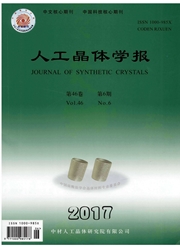

 中文摘要:
中文摘要:
采用固相合成和液相合成两种方法成功制备了Ca9Y0.5La0.5(VO4)7晶体的多晶原料,并采用提拉法生长了尺寸分别为S30mm×33mm(固相合成多晶原料)和犯Omm×27mm(液相合成多晶原料)的Ca9Y0.5La0.5(VO4)7晶体。测试了该晶体在紫外、可见和近红外区域的透过率,采用Kurtz法测试了晶体的粉末倍频效应。结果表明,采用液相合成原料生长的晶体透过率大于采用固相合成原料生长的晶体约10%。前者粉末倍频效应约为KDP的1.8倍,后者约为KDP的2.5倍。晶体化学腐蚀实验表明采用液相合成原料生长的晶体具有更少的缺陷。采用液相合成方法制备多晶原料有利于提高晶体的光学质量。
 英文摘要:
英文摘要:
The polycrystalline materials of Ca9Y0.5La0.5(VO4)7 were prepared by methods of solid-phase and liquid-phase synthesis, respectively. The Ca9Y0.5La0.5(VO4)7 crystals with dimensions of φ30 mm × 33 ram( solid-phase synthesis) and 420 mm × 27 mm (liquid-phase synthesis ) were grown by the Czochralski method successfully. The transmittance of the grown crystals in the UV-VIS-NIR range was measured, and the second harmonic generation efficiency of Ca9Y0.5La0.5(VO4)7 crystal was measured by the Kurtz powder method. The results indicate that the latter has 10% higher transmittance than that of the former. The second harmonic efficiency is about 1.8 times and 2.5 times as large as that of KDP crystal for the former and the latter, respectively. The chemical etching of the crystals shows that there is less defect in the crystal grown from liquid-phase synthesis materials. These results reveal that the liquid- phase synthesis can improve the optical quality of the crystal.
 同期刊论文项目
同期刊论文项目
 同项目期刊论文
同项目期刊论文
 Growth and Spectral Assessment of Yb3+-Doped KBaGd(MoO4)(3) Crystal: A Candidate for Ultrashort Puls
Growth and Spectral Assessment of Yb3+-Doped KBaGd(MoO4)(3) Crystal: A Candidate for Ultrashort Puls Growth, Structure and Spectroscopic Characterization of Nd3+-Doped KBaGd(WO4)(3) Crystal with a Diso
Growth, Structure and Spectroscopic Characterization of Nd3+-Doped KBaGd(WO4)(3) Crystal with a Diso Growth, Thermal and Spectral Properties of Er3+-Doped and Er3+/Yb3+-Codoped Li3Ba2La3(WO4)(8) Crysta
Growth, Thermal and Spectral Properties of Er3+-Doped and Er3+/Yb3+-Codoped Li3Ba2La3(WO4)(8) Crysta 期刊信息
期刊信息
